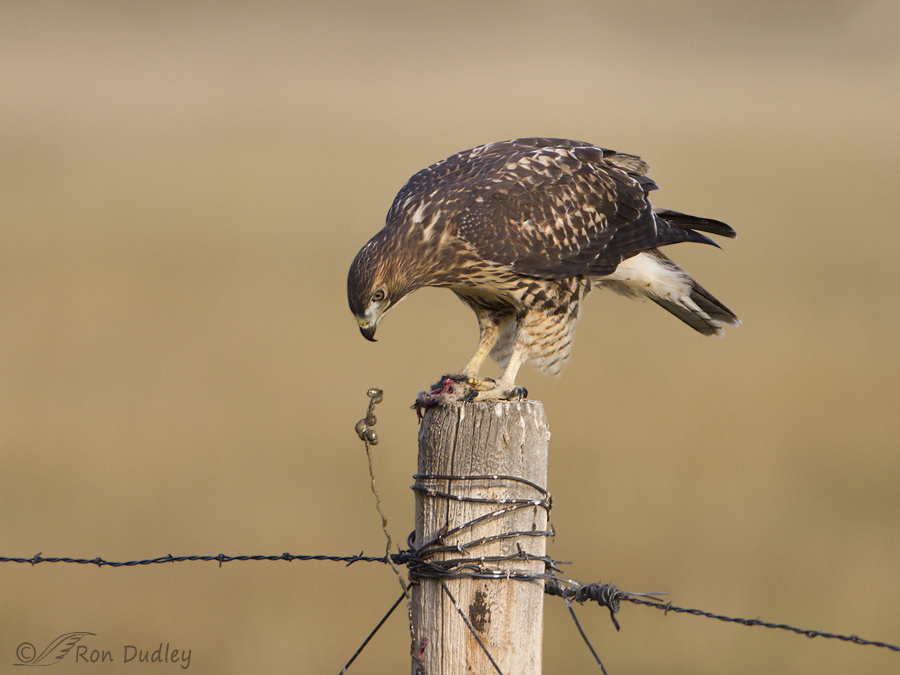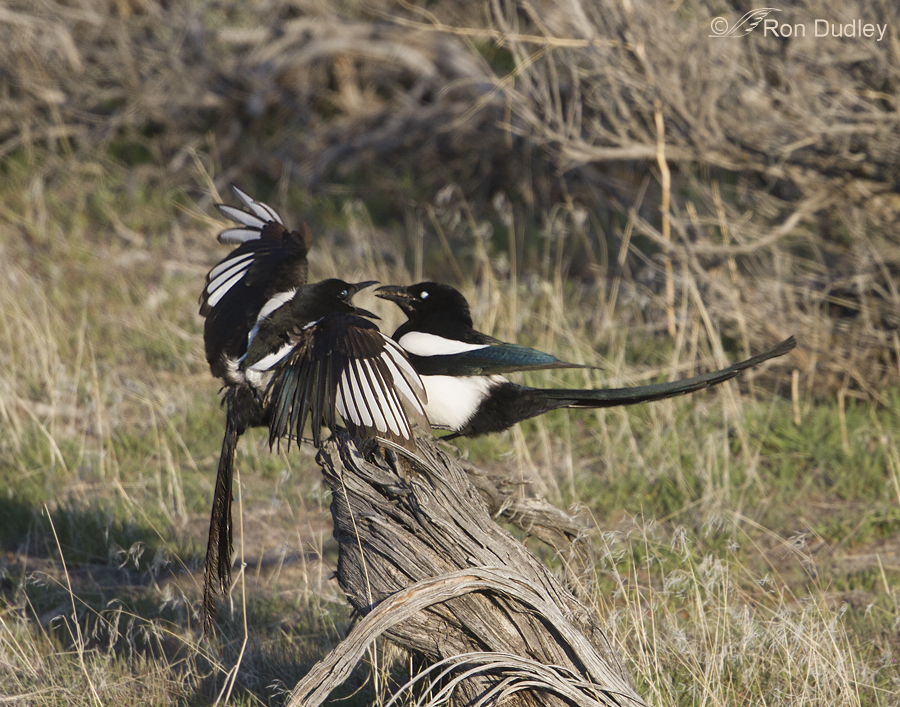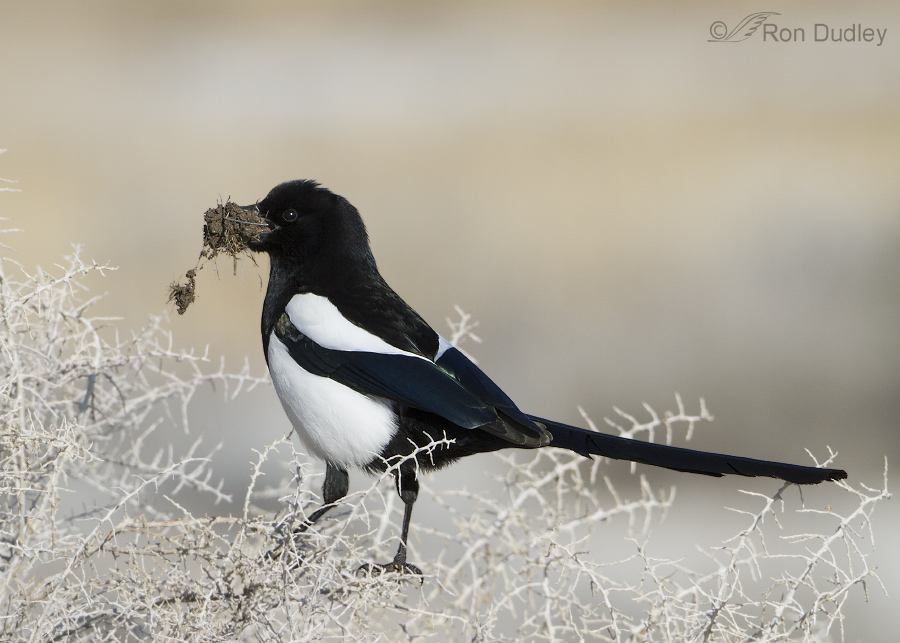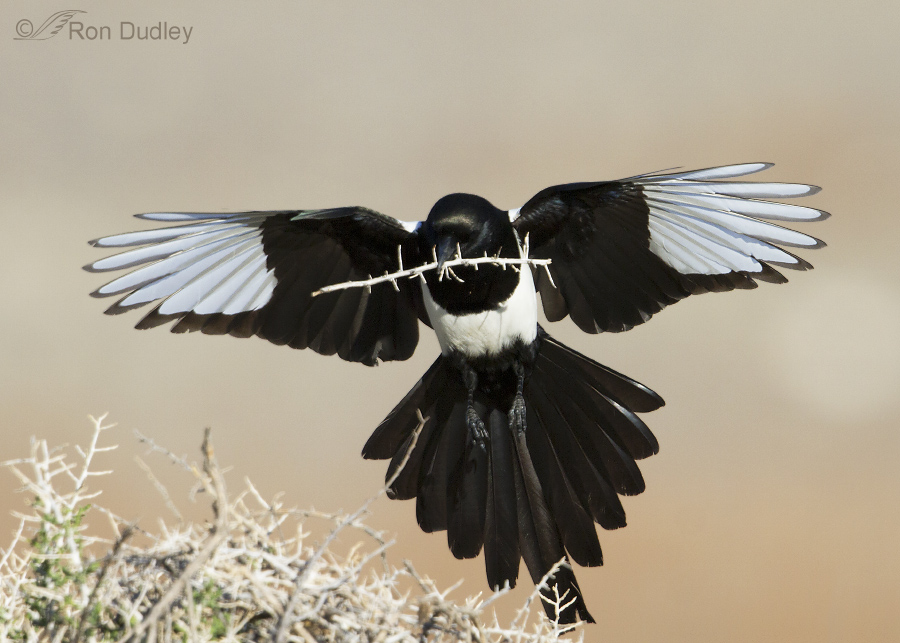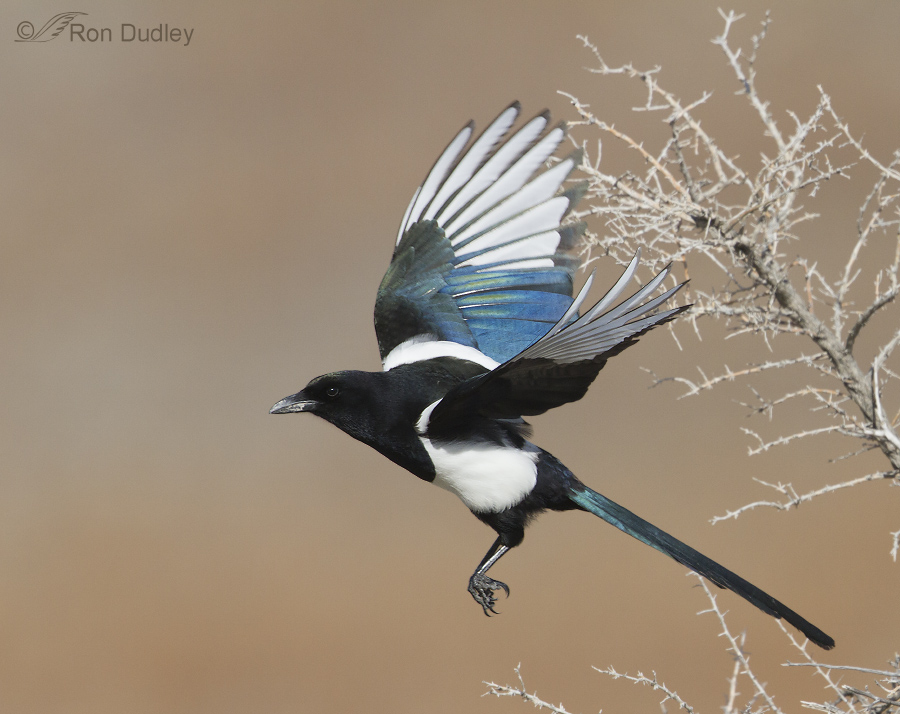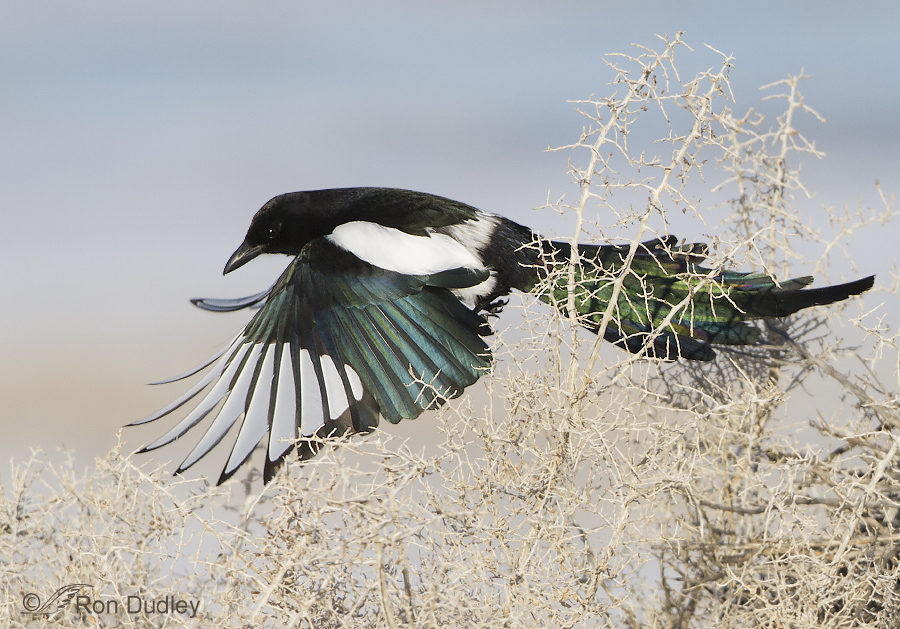Tag: black billed magpie
Bald Eagle In Montana’s Centennial Valley
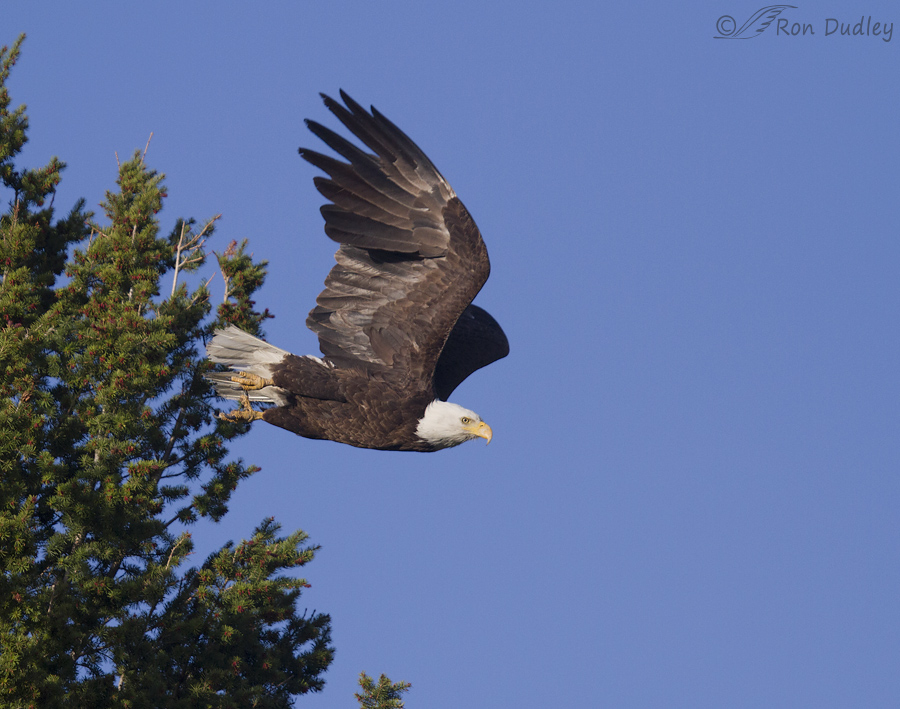
I often photograph Bald Eagles in Utah during winter but for me those images have a different mood (for lack of a better word) because they’re often taken near urban environments and for me they don’t convey the feeling of wildness that I so love about the Centennial Valley. And I very seldom get anything “green” in my Utah Bald Eagle images taken in winter.
Adult Female Magpie Begging For Food
Structural Colors In Birds – Black-billed Magpie
Magpie Hip-shot – An Interesting Experiment
Black-billed Magpie Just After Take-off
Each spring I spend time photographing magpies on Antelope Island. Not many images of them are keepers but this is one I like.
It Must Be Spring – Magpies Are Beginning Nest-building
Black-billed Magpie – Paying The Price For An Ethical Stance
Black-billed Magpie In Full Flight (not taking off)
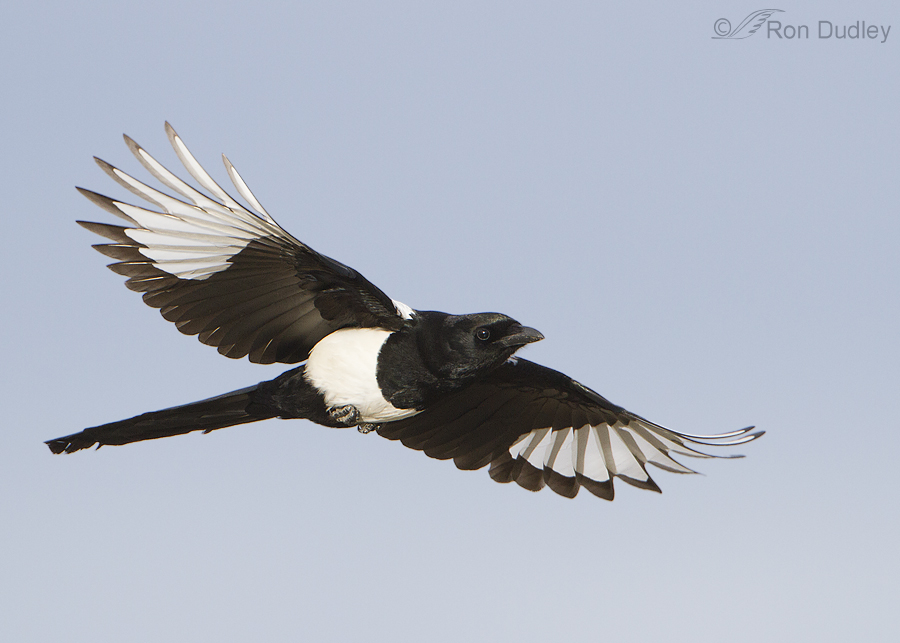
Magpies aren’t among the most glamorous of birds so they don’t get a lot of attention from photographers but I enjoy them for their fascinating behaviors, their gutsiness and their apparent intelligence. And if you want a particularly challenging photographic subject you can’t go wrong with the Black-billed Magpie.
Black-billed Magpie Fledglings
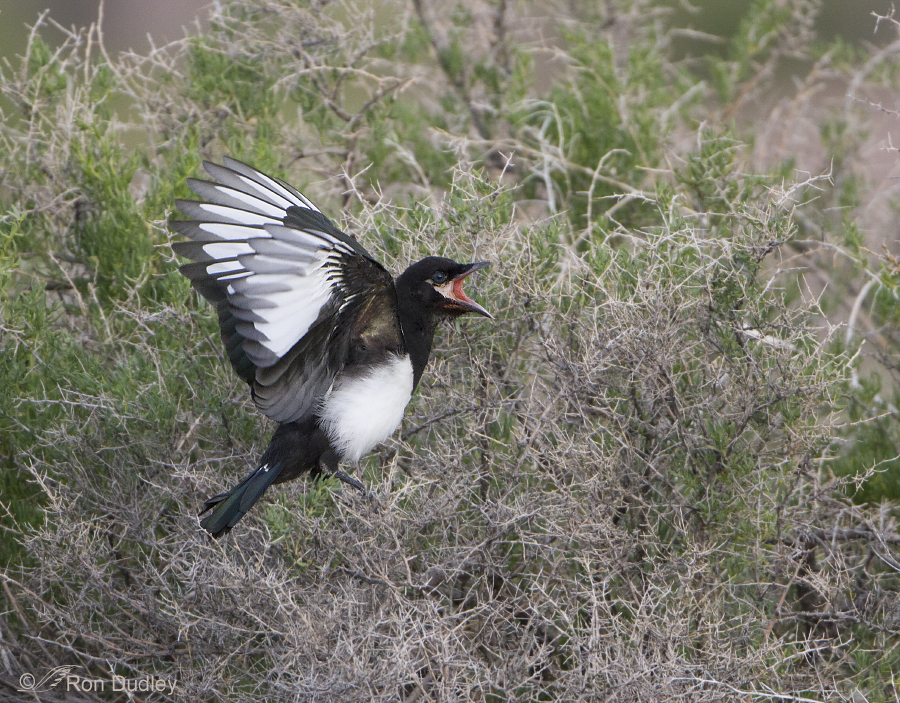
I’ve been watching a Black-billed Magpie nest in a greasewood bush on Antelope Island all spring but the adults are very spooky and always fly off as I approach (the nest is very near a road and I stay in my vehicle on the road). But I’ve been looking forward to seeing the fledglings and I finally got a good look at all five of them last week.
Black-billed Magpies Constructing Their Nest
This post is largely about behavior. The image quality ranges from good to mediocre but I think each photo contributes something to a better understanding of magpies. Black-billed Magpies begin nest-building as early as January and these particular birds have been at it for several weeks now. Actually, in this case it’s more a “remodel” than it is “new construction” since this nest has been used for at least the last three years. All of these photos have been taken this week, which accounts for the relatively bright snow and ice background in some of the shots. 1/2500, f/7.1, ISO 500, 500 f/4, natural light One of the first things you may notice is the fact that sometimes these Black-billed Magpies don’t seem to have black bills. Part of nest construction involves mud gathering and the drying mud on the bill can significantly alter the appearance of the bill. 1/2500, f/7.1, ISO 500, 500 f/4, natural light Both sexes contribute to nest construction and they’re quite industrious in their efforts. The size of the twigs they bring in is often impressive. 1/4000, f/7.1, ISO 500, 500 f/4, natural light The nest is buried deep in a greasewood bush at about eye level for me. Typically a bird bringing in construction material will land on a nearby perch and look over the nest for a few moments – seeming to plan placement of the twig and an approach path through the myriad of vertical greasewood stems that present significant obstacles to proper placement of such an unwieldy…
Magpie Nesting Season Has Begun
I’ve spent the last two mornings photographing Black-billed Magpies in the midst of nest construction. These birds often re-use old nests and this is at least the third year they have used the same one. Even when “recycling” the nest like this, weeks of work go in to refurbishing it – they bring in a completely new lining of grass, mud, rootlets and even bison fur. And they add an amazing number of new twigs to the basic structure. These are industrious birds! I’ve said before that this species is my most challenging avian photographic subject and that fact has been reinforced this week. There are several reasons for that, including: the deep black and bright white combination is hugely difficult to expose properly that aggravatingly long tail makes composition difficult and it is very easy to clip or cut off in action shots they close their nictitating membrane more than any other bird I’ve photographed and when they do its color is a blue-white which is almost shockingly apparent against the black head when they take off from an elevated perch they typically flap once and then fold their wings tightly against the body at exactly the moment when it’s easiest to get them in flight, resulting in what I call a “torpedo-bird” flight posture that is less than desirable the dark eye set against a black head makes it very difficult to get a good catch light in the eye In the last two days I’ve taken over 1200 shots of these magpies and about 95% of them were garbage, largely due…
Black-billed Magpie Iridescence
Black-billed Magpies are loud, flashy and conspicuous black and white birds. And they’re a challenge to photograph well because of the exposure difficulty – getting detail in the blacks without “blowing out” the whites. I probably discard a higher proportion of shots of this species than I do any other. But if you work hard at it (with a little luck thrown into the mix) you can get some pretty spectacular shots that have detail in the blacks and whites and their showy iridescence. The actual plumage of these birds is truly black and white, with no other colors. But in the right light the feather structure (and other factors) on the tail and wings of these birds bends the light much like a prism and produces a variety of colors, predominantly blues and greens. When I’m photographing magpies, one of my goals is usually to capture some of that iridescence. 1/4000, f/6.3, ISO 500, 100-400 @ 400mm, natural light Three days ago I found this magpie perched on a snow-covered boulder on Antelope Island. As you can see the whites are well-exposed but there’s not a lot of detail in the blacks. This is the type of magpie image that I normally wouldn’t do much with except for purposes such as this post (my high shutter speeds were due to the snow and the fact that I was attempting take-off shots). 1/4000, f/6.3, ISO 500, 100-400 @ 400mm, natural light This is the same bird on the same perch but the image was taken…
An Osprey, A Fish And A Thieving Magpie
Yesterday Mia and I returned from a three day camping and photo trip to Flaming Gorge. We had great weather for most of our time there and as usual the scenery and ambience were awesome. At an elevation over 6000′ many of the birds that we usually see there apparently haven’t arrived yet but we spent some quality time with a pair of nesting Osprey – a species that I’ve had little luck with in the past. 1/2000, f/5.6, ISO 500, 500 f/4, 1.4 tc This pole with all the attached ugly hardware was within a few feet of the nesting platform and early one morning this Osprey landed on the pole with a freshly caught fish. At first I figured that this bird would deliver the fish to its mate on the nest (I have a lot to learn about this species) but it didn’t. It’s intention was to eat the fish itself but as you’ll see, those plans were delayed by an interloper. It didn’t take long for this Black-billed Magpie to show up and torment the rightful owner of the fish. This Osprey removed and dropped the intestines in pieces and it seemed obvious to me that the magpie had learned that particular feeding pattern and came looking for tidbits that had landed on the wires below the Osprey. Here you can see one of those bits in the beak of the magpie that it had picked off of the metal above its head. So far the Osprey doesn’t seem too…
A Recent Potpourri Of Birds From Antelope Island
Antelope Island always has an interesting mix of birds for the photographer and birder. During the winter months raptors are one of the primary attractions for me but soon after the cold months are over they begin to thin out and the migrating spring birds begin to appear. The last several weeks have been in transition with fewer raptors but many migrating species are beginning to show up – in addition to the many year-round residents on the island. With this post I thought I’d present a few shots from the past week or so as a small representation of some of the common birds right now. 1/2500, f/6.3, ISO 500, 500 f/4, 1.4 tc Black-billed Magpies are year-round residents of the island and they’re in a nesting frenzy right now which allows for some interesting opportunities for the photographer. This bird is landing on a bush very near its nest. 1/1250, f/7.1, ISO 500, 500 f/4 Springtime is my favorite season to photograph Chukars because they’re all dolled out in fresh plumage and they’re very approachable when they’re calling from rocks. For much of the rest of the year they spend their time scurrying around in the vegetation and it’s quite difficult to get a clean shot. This one was calling with a lot of enthusiasm! 1/3200, f/5.6, ISO 500, 500 f/4, 1.4 tc Some of the Loggerhead Shrikes also remain on the island year-round but their numbers increase noticeably in spring. 1/1000, f/6.3, ISO 640, 500 f/4, 1.4 tc It’s always a treat when the Long-billed Curlews return to…
Bald Eagle In Montana’s Centennial Valley

I often photograph Bald Eagles in Utah during winter but for me those images have a different mood (for lack of a better word) because they’re often taken near urban environments and for me they don’t convey the feeling of wildness that I so love about the Centennial Valley. And I very seldom get anything “green” in my Utah Bald Eagle images taken in winter.
Adult Female Magpie Begging For Food
Structural Colors In Birds – Black-billed Magpie
Magpie Hip-shot – An Interesting Experiment
Black-billed Magpie Just After Take-off
Each spring I spend time photographing magpies on Antelope Island. Not many images of them are keepers but this is one I like.
It Must Be Spring – Magpies Are Beginning Nest-building
Black-billed Magpie – Paying The Price For An Ethical Stance
Black-billed Magpie In Full Flight (not taking off)

Magpies aren’t among the most glamorous of birds so they don’t get a lot of attention from photographers but I enjoy them for their fascinating behaviors, their gutsiness and their apparent intelligence. And if you want a particularly challenging photographic subject you can’t go wrong with the Black-billed Magpie.
Black-billed Magpie Fledglings

I’ve been watching a Black-billed Magpie nest in a greasewood bush on Antelope Island all spring but the adults are very spooky and always fly off as I approach (the nest is very near a road and I stay in my vehicle on the road). But I’ve been looking forward to seeing the fledglings and I finally got a good look at all five of them last week.
Black-billed Magpies Constructing Their Nest
This post is largely about behavior. The image quality ranges from good to mediocre but I think each photo contributes something to a better understanding of magpies. Black-billed Magpies begin nest-building as early as January and these particular birds have been at it for several weeks now. Actually, in this case it’s more a “remodel” than it is “new construction” since this nest has been used for at least the last three years. All of these photos have been taken this week, which accounts for the relatively bright snow and ice background in some of the shots. 1/2500, f/7.1, ISO 500, 500 f/4, natural light One of the first things you may notice is the fact that sometimes these Black-billed Magpies don’t seem to have black bills. Part of nest construction involves mud gathering and the drying mud on the bill can significantly alter the appearance of the bill. 1/2500, f/7.1, ISO 500, 500 f/4, natural light Both sexes contribute to nest construction and they’re quite industrious in their efforts. The size of the twigs they bring in is often impressive. 1/4000, f/7.1, ISO 500, 500 f/4, natural light The nest is buried deep in a greasewood bush at about eye level for me. Typically a bird bringing in construction material will land on a nearby perch and look over the nest for a few moments – seeming to plan placement of the twig and an approach path through the myriad of vertical greasewood stems that present significant obstacles to proper placement of such an unwieldy…
Magpie Nesting Season Has Begun
I’ve spent the last two mornings photographing Black-billed Magpies in the midst of nest construction. These birds often re-use old nests and this is at least the third year they have used the same one. Even when “recycling” the nest like this, weeks of work go in to refurbishing it – they bring in a completely new lining of grass, mud, rootlets and even bison fur. And they add an amazing number of new twigs to the basic structure. These are industrious birds! I’ve said before that this species is my most challenging avian photographic subject and that fact has been reinforced this week. There are several reasons for that, including: the deep black and bright white combination is hugely difficult to expose properly that aggravatingly long tail makes composition difficult and it is very easy to clip or cut off in action shots they close their nictitating membrane more than any other bird I’ve photographed and when they do its color is a blue-white which is almost shockingly apparent against the black head when they take off from an elevated perch they typically flap once and then fold their wings tightly against the body at exactly the moment when it’s easiest to get them in flight, resulting in what I call a “torpedo-bird” flight posture that is less than desirable the dark eye set against a black head makes it very difficult to get a good catch light in the eye In the last two days I’ve taken over 1200 shots of these magpies and about 95% of them were garbage, largely due…
Black-billed Magpie Iridescence
Black-billed Magpies are loud, flashy and conspicuous black and white birds. And they’re a challenge to photograph well because of the exposure difficulty – getting detail in the blacks without “blowing out” the whites. I probably discard a higher proportion of shots of this species than I do any other. But if you work hard at it (with a little luck thrown into the mix) you can get some pretty spectacular shots that have detail in the blacks and whites and their showy iridescence. The actual plumage of these birds is truly black and white, with no other colors. But in the right light the feather structure (and other factors) on the tail and wings of these birds bends the light much like a prism and produces a variety of colors, predominantly blues and greens. When I’m photographing magpies, one of my goals is usually to capture some of that iridescence. 1/4000, f/6.3, ISO 500, 100-400 @ 400mm, natural light Three days ago I found this magpie perched on a snow-covered boulder on Antelope Island. As you can see the whites are well-exposed but there’s not a lot of detail in the blacks. This is the type of magpie image that I normally wouldn’t do much with except for purposes such as this post (my high shutter speeds were due to the snow and the fact that I was attempting take-off shots). 1/4000, f/6.3, ISO 500, 100-400 @ 400mm, natural light This is the same bird on the same perch but the image was taken…
An Osprey, A Fish And A Thieving Magpie
Yesterday Mia and I returned from a three day camping and photo trip to Flaming Gorge. We had great weather for most of our time there and as usual the scenery and ambience were awesome. At an elevation over 6000′ many of the birds that we usually see there apparently haven’t arrived yet but we spent some quality time with a pair of nesting Osprey – a species that I’ve had little luck with in the past. 1/2000, f/5.6, ISO 500, 500 f/4, 1.4 tc This pole with all the attached ugly hardware was within a few feet of the nesting platform and early one morning this Osprey landed on the pole with a freshly caught fish. At first I figured that this bird would deliver the fish to its mate on the nest (I have a lot to learn about this species) but it didn’t. It’s intention was to eat the fish itself but as you’ll see, those plans were delayed by an interloper. It didn’t take long for this Black-billed Magpie to show up and torment the rightful owner of the fish. This Osprey removed and dropped the intestines in pieces and it seemed obvious to me that the magpie had learned that particular feeding pattern and came looking for tidbits that had landed on the wires below the Osprey. Here you can see one of those bits in the beak of the magpie that it had picked off of the metal above its head. So far the Osprey doesn’t seem too…
A Recent Potpourri Of Birds From Antelope Island
Antelope Island always has an interesting mix of birds for the photographer and birder. During the winter months raptors are one of the primary attractions for me but soon after the cold months are over they begin to thin out and the migrating spring birds begin to appear. The last several weeks have been in transition with fewer raptors but many migrating species are beginning to show up – in addition to the many year-round residents on the island. With this post I thought I’d present a few shots from the past week or so as a small representation of some of the common birds right now. 1/2500, f/6.3, ISO 500, 500 f/4, 1.4 tc Black-billed Magpies are year-round residents of the island and they’re in a nesting frenzy right now which allows for some interesting opportunities for the photographer. This bird is landing on a bush very near its nest. 1/1250, f/7.1, ISO 500, 500 f/4 Springtime is my favorite season to photograph Chukars because they’re all dolled out in fresh plumage and they’re very approachable when they’re calling from rocks. For much of the rest of the year they spend their time scurrying around in the vegetation and it’s quite difficult to get a clean shot. This one was calling with a lot of enthusiasm! 1/3200, f/5.6, ISO 500, 500 f/4, 1.4 tc Some of the Loggerhead Shrikes also remain on the island year-round but their numbers increase noticeably in spring. 1/1000, f/6.3, ISO 640, 500 f/4, 1.4 tc It’s always a treat when the Long-billed Curlews return to…


